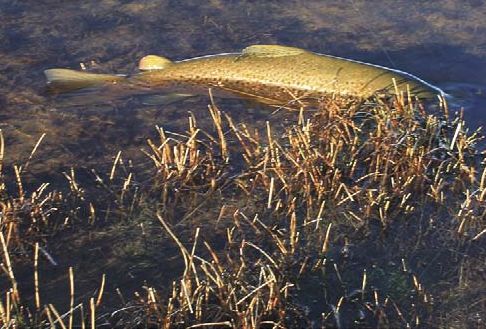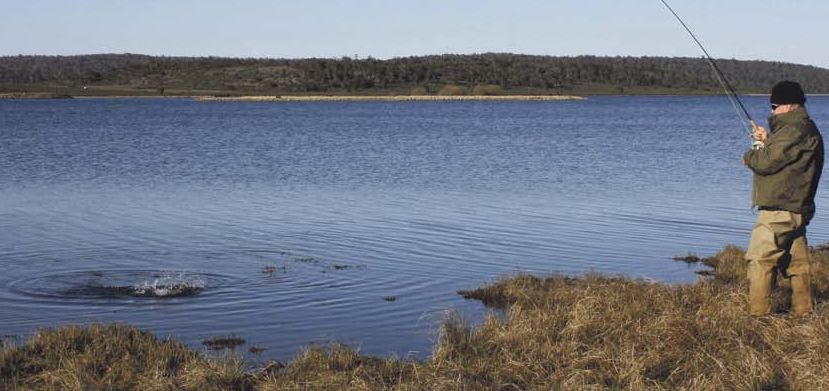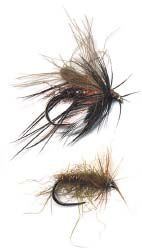 Presented from Issue 112, October 2014
Presented from Issue 112, October 2014
October, November what a great time of year to be fishing for trout around the highland lakes. As spring progresses the weather is becoming more stable, temperatures are going up, both the air and water temperatures which in turn are making more food available for trout. The odd terrestrial beetle is getting around; aquatic hatches are commencing, midge, then the diminutive Stone fly, Caddis and then Mayfly. Trout aren’t necessarily hugging the bottom anymore and begin to freely rise when the food is there to tempt them to the surface.
Where ever the conditions permit, trout will be drawn close to shore to make the most of hatches commencing in the warmer shallows where the larval stages of these bugs are emerging and also sheltering around tussocks, trees and shrubs. Arthurs Lake is a great example of this habitat with water levels being consistently high for the last few years.
 The shores around Arthurs features submerged grasses and kerosene bush, ideal habitat for nymphs but also for adults to shelter before mating and passing on progeny for the coming years. Food and shelter also feature highly on the trout’s requirements so the recipe is there for some excellent opportunities for sport. Add to all of this the perfect habitat for frogs and the predatory dragonfly larvae then the trout have all the fodder they could hope for. Anywhere the water has reclaimed grass or tree terrestrial insects will fall victim and aquatic insects will move in making it a great opportunity for the trout.
The shores around Arthurs features submerged grasses and kerosene bush, ideal habitat for nymphs but also for adults to shelter before mating and passing on progeny for the coming years. Food and shelter also feature highly on the trout’s requirements so the recipe is there for some excellent opportunities for sport. Add to all of this the perfect habitat for frogs and the predatory dragonfly larvae then the trout have all the fodder they could hope for. Anywhere the water has reclaimed grass or tree terrestrial insects will fall victim and aquatic insects will move in making it a great opportunity for the trout.
There’s many different ways to fish around the shore when there isn’t a clear rise going on. Depending on how the fish are likely to behave on a given day should dictate how to fish around the verges.
The fish of course will be on both the lee shore and the windward shore, however which will fish better? It’s easy if you’ve got on a boat and can quickly access either shore.
Always looking for a rising or moving trout to cast to, I like to cruise a section of in the lee of the shore to attempt to spot any rising fish. This calm shore will generate smooth water around the submerged shrubbery and out to the ripple line where the breeze will take effect from, this is good territory to drift a static dry fly. Because it’s calm, it is less likely to have submerged food freely available for the trout so if no fish are moving and no large amounts of food are on the surface it’s over to the bottom of the wind.
On this windy shore the food is being moved about by the wave action, if the wind isn’t too harsh it is easy to wade or to work along this shore by boat, particularly if you have an electric motor to poke you back out when you encroach on the shallows or drowned vegetation. Here you can fish blind very effectively.
The general rules I apply to fishing for trout apply here, the brighter and calmer the weather the smaller and slower I fish. In brighter weather an intermediate line with traditional wets such as the mallard and claret, or a wet hopper pattern or cormorant. In overcast weather a wake fly such as a muddler or claret dabbler and small wets trailing with a figure 8 retrieve is a great way to fish. A very exciting way to fish this structure is to cast bigger wets into gaps in the structure and retrieve he flies flat out. Trout are given a moment to make a decision about a good size morsel and takes can be savage and very visual with the fish proposing over the fly or visibly smashing the flies near the surface. Its exciting fishing although not everyone’s cup of tea.
The best fishing round this structure is obviously when there’s a good rise of trout to food on the surface; generally this is when the calm shore comes into its own. Early morning, spent sedge and midge and other small food settles on the water. The rises around this area can be fantastic. The trout will mop up all of this food and they tend to throw caution to the wind either in their gluttony or being lulled into a false sense of security in amongst the safety of the structure.
On shallow water where there is less structure more typical tailing water, the trout are more cautious and easily spooked. Small drab coloured dry flies work a treat. My favourites being a Bobs Bits in a tan or fiery brown colour. This simple fly born from the pilling of wool on Mr Bob’s pullover, with a cheap thin hackle is a great all round dry fly when you want a low sitting but very buoyant fly.
Brought to Tasmania by the visiting England team angler John Horsey this and the pommie hopper pattern have now become main stay flies on the dry fly box. Tied now with seals fur, the colour of your choice and still with the thin cheap cock hackle
 |
| Bibio Hopper and a Bob’s Bits |
Bobs Bits is a greatly versatile fly. Flies that sit low in the water are best for the spent insect mopping up in the morning and this fly fits perfectly into that profile. Daytime and evening, spontaneous localised rises will occur where the wind takes effect to blow food out from shelter over the water. Again static dries or mobile dries such as the Bibio Hopper twitched in the surface are super effective.
On evening the Caddis will come out of the trees in the calm to flutter over the water and lay eggs, again static dry fly is good, but mobile dries such as the pommie hoppers and small palmered dries tweaked in the surface are deadly.
These opportunities exist all over the highlands wherever water levels are suitable, however having just had a few days fishing at the end of September, Arthurs Lake is perfect in many areas. Being that most of our wind has some element of west in it, then the road shore of Cow Paddock Bay, the back of Brazendale Island, the western shores of Seven Pound Bay, Jones and Fleming bays all have good localised rises in the lee. Bright weather can often activate activity from the insects and therefore also the trout.
October and November will present the first glimpses of the great dry fly fishing available in the Highlands. Watch the water levels of our lakes and look for opportunities to fish the shallows where ever they appear, either by newly inundated land or among established weed beds and timber. The first hatches will occur in shallow water making some of the best fishing this time of year available to everyone.
Joe Riley




